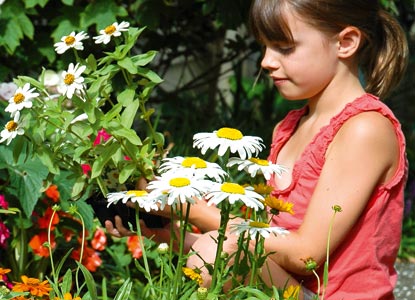Your garden can be a great place for kids to learn
**Tussie-mussie garden
**Little girls love creating and presenting tussie-mussies or little bouquets of freshly picked flowers – and teachers love receiving them too. Flowers are uplifting and they’re great for decorating bare classrooms at the beginning of the year. To grow a tussie-mussie garden, dig up a small patch of garden and get the kids to plant a bunch of inexpensive potted-colour annuals. It’s best to choose the kind of flowers which have a good stem for picking. A few of my favourites are zinnia, cosmos, verbena and blue salvia – all of which will flower right through to late autumn and will provide plenty of nectar to attract butterflies into the garden as well.
**Did you know?
**Traditional old English tussie-mussies usually consisted of a large rose surrounded by fragrant bunches of herbs like rosemary, thyme and rue. Tussie-mussies were held close to the nose to ward off horrid smells in the streets and protect their carriers from infectious diseases.
**Encourage monarchs
**oonarch butterflies are plentiful in late summer, landing fleetingly to feed on various nectar plants. But the only plant that they lay their eggs on and the only plant monarch caterpillars feed on is the swan plant (Asclepias). It’s therefore imperative we plant plenty of swan plants to perpetuate populations of this lovely creature. The trick is to plant several swan plants as monarch caterpillars are voracious feeders.
They need to fatten up and store energy before pupating (turning into a chrysalis). If the kids get distressed because their swan plants are stripped of foliage, carefully remove the adult caterpillars. Put them in a box with a few branches from which caterpillars can ‘hang’ to form pupae. Give them pumpkin to feed on, but never feed pumpkin to young caterpillars as they will not form properly.
**Did you know?
**The swan plant’s milky sap is full of toxins that transfer to monarchs when they eat it. This acts protects the caterpillars from birds and other predators, who recognise that their distinctive colours mean poison.
**Save food miles
**Snow peas are often imported into New Zealand from Zimbabwe! I’m confounded as to why we import them when they’re such an easy crop to grow and can be sown throughout most of New Zealand from spring to late summer or autumn and winter in frost-free areas. Get the kids to soak a few seeds overnight, then sow them against a fence or trellis into well-worked, damp soil with a little lime and general fertiliser added. Cover the seed row with wire netting to prevent birds dining on newly germinated seedlings. Remove the wire when seedlings are about 10cm tall. Pick snow peas daily when they’re about 6cm long and at their best – crisp but tender.
**Did you know?
**Snow peas are also known by their French name mange tout, which in English means “eat all”. They contain high levels of carotenoids and useful amounts of vitamins B1 and B6, plus iron and folate, making them a healthy snack for school lunches or afternoon tea.
**Sustainability in schools
**It’s fantastic to see the positive action many of our nation’s schools are taking in getting the important message of sustainability across to our children. The Enviroschools Foundation and the Waste Wise organic Recycling Programme are two such organisations working in our schools to encourage the current generation to instinctively think and act sustainably. oany schools have their own vege gardens and worm-composting systems and from all accounts, the kids just love it!




